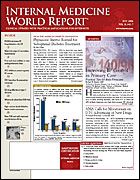Publication
Article
Internal Medicine World Report
AIDS at 25 Years: Much Progress, Urgent Challenges
Author(s):
252,000-312,000 Americans Don’t Know They Are Infected
MMWR
More than 1 million Americans are living with AIDS today, 25 years after physicians first observed the emergence of a virus that evolved into a rapidly progressing “gay disease” and then into a full-fledged pandemic. At this 25th HIV/AIDS juncture, the Centers for Disease Control and Prevention (CDC) has issued a report on the state of the disease, highlighting successes in HIV prevention and treatment as well as listing remaining challenges (. 2006;55:585-620).
Morbidity and Mortality Weekly Report
Pneumocystis carinii
The account published in the June 5, 1981, issue of (1981;30:250-252) describing pneumonia in 5 young California men was the bellwether of the epidemic. Despite advances in treatment and prevention in the intervening years, the number of those living with HIV/AIDS today is increasing, in part, because many of those infected are not aware of their HIV status. Before this year ends, estimates suggest that there will be 40,000 new HIV infections. Thus, although many primary care physicians are not treating HIV infection per se, such a pervasive lack of awareness of the disease should alarm all physicians and prompt increased vigilance when it comes to HIV testing and taking the medical history.
The face of HIV/AIDS has changed in the past quarter century. The wide gender gap characteristic of the early years of the epidemic (1981-1995), when men accounted for nearly 85% of cases, has narrowed. At the end of 2003, almost 30% of HIV/AIDS cases were diagnosed in women.
One of the greatest successes has been the dramatic decline in mother-to-child HIV transmission. The number of infants who acquired HIV infection perinatally dropped from its peak of 1650 in 1991 to about 236 in 2002.
The most urgent remaining challenge, notes the CDC, is reducing the number of Americans who do not know they are infected, which is currently estimated at 252,000 to 312,000 people.
The CDC reiterates the need for better prevention, education, and intervention efforts aimed at the following groups:
• Men who have sex with men, who currently account for almost 50% of all newly reported HIV/AIDS cases
• Blacks, who in some areas account for roughly 45% of all new HIV/ AIDS cases, despite being only about 13% of the population
• Women, who account for about 25% of new HIV/AIDS cases; in black women aged 25 to 34 years, HIV infection was the leading cause of death in 2002
• The general public, only 26% of whom view AIDS as a leading health concern.
Key strategies for meeting these challenges include:
• Establishing partnerships in the medical and lay communities to fight the spread of HIV
• Making voluntary HIV testing easier
• Focusing prevention messages on infected and uninfected individuals; highlighting the role of alcohol and drug abuse in HIV transmission
• Combining prevention programs
• Better surveillance, especially if the 7 remaining states will join the 43 others in confidential HIV case reporting this year
• Improving prevention technologies, programs to promote behavior change, and counseling.






